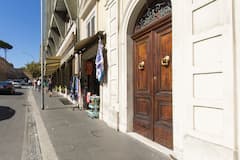You can expect Vatican City (Citta del Vaticano) to be at the top of most travelers’ lists when they are making the trip to Rome, Italy. Even though it can take months to see all of what the Eternal City (Rome) has to offer, some will even tell you that your trip was not complete if you’ve left the smallest country in the world off of your list.
For those who may not know, the Vatican is its own country, taking up the tiny space of only 44 hectares (108.7 acres). However, there is so much to see here, including the Vatican Museums (Musei Vaticani), which is also home to the very famous Sistine Chapel.
Read on to learn the importance of the museums (which are located in the same vicinity), so you know exactly which ones you want to spend more time in, or see first.
Ancient artifacts from the 1st to the 5th centuries

The Gregorian Etruscan (Gregoriano Etrusco) and the Gregorian Egyptian Museum (Museo Gregoriano Egiziano) are located right next to each other. Pope Gregory XVI founded these two museums, and you will see many ancient artifacts dating back to the year 1828 that were discovered during the excavations that took place in southern Etruria, which is known today as northern Latium.
There are 22 rooms that showcase many decorated vases, bronze artifacts that were once used for funerary purposes. There is even a very rare statue called Mars of Todi that was completed in the 5th century BC. You will also see many sarcophagi dating back to the 2nd, 3rd, and 4th centuries. Not to mention the stunning gold collection of jewelry pieces from the 4th and 6th centuries, and one that’s really eye-catching is the necklace with the medallions.
If you look closely at the medallions, you will see mythological depictions such as the Greek god, Hephaestus, preparing to make warrior Achilles’ armor and helmet. When you step into the Egyptian Museum, you’ll notice it’s a bit smaller, but there are many fascinating statues to look at, and one that is definitely worth gazing at a second longer is the statue of the god Anubis that dates back to the 1st and 2nd century AD. Anubis is known for being the original god of the dead, and may just be the most iconic god of ancient Egypt.
What to look for in Raphael's Rooms

Continuing on, there are four rooms, in a section known as Raphael’s Rooms (Stanze di Raffaello) that are intricately adorned with religious frescoes from floor to ceiling. The Room of Constantine is important because Constantine was the first Christian emperor to grant the freedom of worship to others. You will see other areas devoted to him throughout Rome, such as the Arch of Constantine and the Colossus of Constantine in the Capitoline Museums (Musei Capitolini).
In the paintings that you see around you, there are four scenarios from his life testifying to the victory over Paganism. The Room of Heliodorus documents various important episodes from the Old Testament as well as medieval history. If you look at the painting with the cage over the cross, this is known as the Liberation of Saint Peter (Liberazione di San Pietro), and was painted in 1514. Peter was an apostle, and was held prisoner in Jerusalem for his religious beliefs by King Herod who had the intentions to persecute him.
Being that it was the night before he was to be put on trial, Saint Peter was chained to the prison walls, sleeping between two soldiers who were watching after him. However, during the night an angel appeared to him, shining a bright light throughout the cell that caught the attention of one of the guards, who then woke up his fellow comrades as Saint Peter made his miraculous exit.
Don't miss the Room of Segnatura

The frescoes in the Room of Segnatura display the start of the high Renaissance. Pope Julius II, who remained pontiff from 1503 until his death in 1513, actually used this room as his library and private office. The paintings are illustrated to represent the beauty, truth, and the good in people.
If you go to the Room of the Fire in the Borgo, you will see that the paintings reflect the inclination of Leo X by taking stories from previous Popes who had the same name. Pope Leo X became pontiff right after the death of Julius II in 1513, up until his own death in 1521, and as all the art displayed here is important, pay special attention to the Justification of Leo III and the Crowning of Charlemagne. Right before Leo III was to become Pope in AD 795, he received a letter from Charlemagne, who at the time was King of the Francs, congratulating him, and telling him he would be a great benefactor to the churches of Rome.
However, the letter also reminded him that he had more obligations over spirituality, while Charlemagne was to defend the Church, and deal with the more worldly matters. Pope Hadrian I, who was the previous Pope before Leo III, had many succeeding family members who saw Leo III as being unfit to take on the role of the Pope because he wanted the Church to control the people’s daily lives as well as their spiritual ones, and therefore plotted against him. There was an attack on Leo III during the celebration of the Greater Litanies (annually observed by the Catholic Church) on April 25th 799.
A group of armed men ran him into the ground with the intentions of cutting out his tongue and gouging his eyes. Needless to say, he was only rendered unconscious, and was saved by two of King Charlemagne’s men. Apparently, the plot against him did spread and his enemies falsely accused him of perjury and adultery, and this is why he was attacked. So, a year later in AD 800, Leo III decided to take an oath of purgation, to cleanse him of his ‘wrongdoings’, and afterwards had his enemies exiled.
Leo III’s next move was to regain respect from the people, and two days after he took the oath, on Christmas day, (he had called Charlemagne, who was loved by all, to Rome earlier to “thank him”) he asked Charlemagne to kneel with him in front of everyone to pray together. Charlemagne had no idea what was coming next as Leo III set a crown on top of his head and named him the Holy Roman Emperor.
You might be interested in these Airbnbs!
Artwork from the 12th to the 19th century

The Pinacoteca is a new art gallery that was put on display in the Vatican Museums on October 27th 1932. The Pinacoteca is made up of 18 rooms, showcasing different artwork from the 12th all the way to the 19th century.
Veronese, Caravaggio, Crespi, Beato Angelico, Giotto, and Melozzo da Forli are some the greatest artists in history when it comes to Italian paintings, and you will see many masterpieces that these artists created. It’s especially neat to see the similarities, as well as the differences, in each of the pieces, especially throughout the centuries.
Historians will love this area

Another great area to visit is the Ethnological Museum that was originally located in the Lateran Palace, which was previously known as the Apostolic Palace of the Lateran, in 1884. Though, in 1970 Pope John XXIII had everything moved to the Vatican. It wasn’t until November of 2012 when this section finally was introduced and opened to the public.
You will have the chance to take a journey through different cultures throughout Africa, Europe, America, and Oceania. Some of the 40,000 artifacts and historical fragments that are on display here date back to around 3000 years ago.
You’ll be able to view some captivating models of different places of worship, that are non-Catholic, such as the Altar of Confucius and Beijing’s Temple of the Sky (made in the 15th century but later was redone in the 18th century). Many Buddhist statues showing devotional practices throughout Indonesia, India, and Tibet are also shown here, along with other neat tokens from the Islamic and Central African cultures.
Arrive early to avoid the crowds
Many other sections make up the Vatican Museums such as the Gallery of Tapestries, the Vatican Courtyards, the Borgia Apartment, and of course the Sistine Chapel. I would recommend that you arrive pretty early in the morning, as it will take you more than just a few hours to view these treasures.
Also, the earlier you get here, the less waiting in line you have to do, as I’ve seen people wrapped around the entirety of the outer walls before. Many of the museums will be closed on Monday, but the Vatican Museums close on Sunday instead, and this is a great place to go to beat the Monday blues.
Equally important, is that on the last Sunday of the month, the museum will be open until 2pm (unless it’s Easter Sunday, the 29th of June, or Christmas), and it’s free to enter from 9am until 12:30pm. Regularly, the Ticket Office stays open from 9am until 4pm, although the museum does not close until 6pm. You can expect to pay 16 EUR (18.22 USD) per person, or if you have a Roma Pass or Omnia Card you can use this for free admission, but keep in mind you only get 2 free admissions per pass.
History
Get Trip101 in your inbox
Unsubscribe in one click. See our Privacy Policy for more information on how we use your data















Create an account to